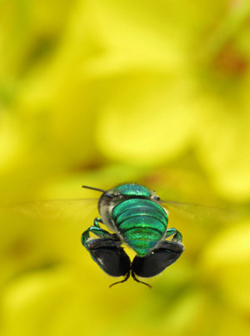Fragrances and speciation in orchid bees |
||
DFG Project EL 249/3 Our current research focusses on whether mutations in the olfactory system of orchid bees can drive speciation. Scent-perception of males and females could be affected by the same mutation, e.g. in an olfactory receptor gene, changing both male trait (accumulated fragrance phenotype) and female preference (for the male frgarance phenotype) alike. Assortative mating of olfactory morphs could theoretically lead to population divergence even in sympatry. We find evidence for olfactory differentiation in sympatric populations of two sibling species of Euglossa in southern Mexico (previously believed to be a single species, Euglossa viridissima). GC/MS analyses of hind leg extracts showed bimodal variation in male fragrance phenotypes, mostly based on the presence/absence of a single diagnostic compound. The differences of fragrance phenotypes corresponded with population genetic markers. Population divergence may have been be driven by olfactory differentiation with respect to the mentioned diagnostic compound: Males that lack this compound also exhibit significantly smaller responses to it in electroantennogram (EAG) tests, while showing identical responses to all other tested stimuli (Eltz et al. 2008). Eltz, T., Zimmermann, Y., Pfeiffer, C., Ramírez Pech, J., Twele, R., Francke, W., Quezada-Euan, J.J.G., Lunau, K. (2008): An olfactory shift is associated with male perfume differentiation and species divergence in orchid bees. Current Biology 18, 1844-1848. PDF Dispatch by Duncan Jackson |
|
RUB » Dekanat für Biologie und Biotechnologie » Evolutionsökologie und Biodiversität der Tiere - Mitarbeiterhomepage PD Dr. Th. Eltz


